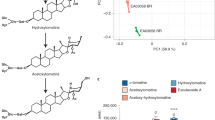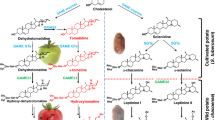Abstract
The trend to view many foods not only as sustenance but also as medicine, so-called functional foods, is increasing. Phenolics are the most widespread dietary antioxidants, and among these, chlorogenic acid (CGA) accumulates to high levels in some crop plants. CGA acts as an antioxidant in plants and protects against degenerative, age-related diseases in animals when supplied in their diet. cDNA clones encoding the enzyme that synthesizes CGA, hydroxycinnamoyl-CoA quinate: hydroxycinnamoyl transferase (HQT), were characterized from tomato and tobacco. Gene silencing proved HQT to be the principal route for accumulation of CGA in solanaceous species. Overexpression of HQT in tomato caused plants to accumulate higher levels of CGA, with no side-effects on the levels of other soluble phenolics, and to show improved antioxidant capacity and resistance to infection by a bacterial pathogen. Tomatoes with elevated CGA levels could be used in foods with specific benefits for human health.
This is a preview of subscription content, access via your institution
Access options
Subscribe to this journal
Receive 12 print issues and online access
$209.00 per year
only $17.42 per issue
Buy this article
- Purchase on Springer Link
- Instant access to full article PDF
Prices may be subject to local taxes which are calculated during checkout






Similar content being viewed by others
References
Ness, A.R. & Powles, J.W. Fruit and vegetables and cardiovascular disease: A review. Int. J. Epidemiol. 26, 1–13 (1997).
Segasothy, M. & Phillips P.A. Vegetarian diet: panacea for modern lifestyle diseases? Q.J. Med. 92, 531–544 (1999).
Bazzano, L.A. et al. Fruit and vegetable intake and risk of cardiovascular disease in US adults, the first National Health and Nutrition Examination Survey Epidemiologic Follow-up Study. Am. J. Clin. Nutr. 76, 93–99 (2002).
Laranjinha, J.A.N., Almeida, L.M. & Madeira, V.M. Reactivity of dietary phenolic acids with peroxyl radicals: antioxidant activity upon low density lipoprotein peroxidation. Biochem. Pharmacol. 48, 487–494 (1994).
Sawa, T., Nakao, M., Akaike, T., Ono, K. & Maeda, H. Alkylperoxyl radical-scavenging activity of various flavonoids and other phenolic compounds: Implications for the anti-tumor-promoter effect of vegetables. J. Agric. Food Chem. 47, 397–402 (1999).
Plumb, G.W. et al. Metabolism of chlorogenic acid by human plasma, liver, intestine and gut microflora. J. Sci. Food Agric. 79, 390–392 (1999).
Williamson, G., Day, A.J., Plumb, G.W. & Couteau, D. Human metabolic pathways of dietary flavonoids and hydroxycinnamates. Biochem. Soc. Trans. 28, 16–22 (2000).
Nardini, M., Cirillo, E., Natella, F. & Scaccini, C. Absorption of phenolic acids in humans after coffee consumption. J. Agric. Food Chem. 50, 5735–5741 (2002).
Couteau, D., McCartney, A.L., Gibson, G.R., Williamson, G. & Faulds, C.B. Isolation and characterisation of human colonic bacteria able to hydrolyse chlorogenic acid. J. Applied Microbiol. 90 873–881 (2001).
Scalbert, A., Morand, C., Manach, C. & Rémésy, C. Absorption and metabolism of polyphenols in the gut and impact on health. Biomed. Pharmacother. 56, 276–282 (2002).
Rice-Evans, C.A., Miller, J. & Paganga, G. Antioxidant properties of phenolic compounds. Trends Plant Sci. 2, 152–159 (1997).
Daniels, D.G.H., King, H.G.C. & Martin, H.F. Antioxidants in oats: Esters of phenolic acids. J. Sci. Food Agric. 14, 385–390 (1963).
Daniels, D.G.H, & Martin, H.F. Antioxidants in oats: Mono-esters of caffeic and ferulic acids. J. Sci. Food Agric. 18, 589–595 (1967).
Leatham, G.F., King, V. & Stahmann, M.A. In vitro protein polymerization by quinones or free-radicals generated by plant or fungal oxidative-enzymes. Phytopath. 70, 1134–1140 (1980).
Tamagnone, L. et al. Inhibition of phenolic acid metabolism results in precocious cell death and altered cell morphology–in leaves of transgenic tobacco plants. Plant Cell 10, 1801–1816 (1998).
Stöckigt, J. & Zenk, M.H. Enzymatic synthesis of chlorogenic acid from caffeoyl coenzyme A and quinic acid. FEBS Lett. 42, 131–134 (1974).
Ulbrich, B. & Zenk, M.H. Partial purification and properties of hydroxycinnamoyl-CoA: quinate hydroxycinnamoyl transferase from higher plants. Phytochem. 18, 929–933 (1979).
Rhodes, M.J.C. & Wooltorton, L.S.C. The enzymatic conversion of hydroxycinnamic acids to p-coumaroyl quinic and chlorogenic acids in tomato. Phytochem. 15, 947–951 (1976).
Villegas, R.J.A. & Kojima, M. Purification and characterisation of hydroxycinnamoyl d-glucose quinate hydroxycinnamoyl transferase in the root of sweet potato, Ipomoea batatas LAM. J. Biol. Chem. 261, 8729–8733 (1986).
Schoch, G. et al. CYP98A3 from Arabidopsis thaliana is a 3′ hydroxylase of phenolic esters, a missing link in the phenylpropanoid pathway. J. Biol. Chem. 276, 36566–36574 (2001).
Franke, R. et al. The Arabidopsis REF8 gene encodes the 3-hydroxylase of phenylpropanoid metabolism. Plant J. 30, 33–45 (2002).
Hoffmann, L., Maury, S., Martz, F., Geoffroy, P. & Legrand, M. Purification, cloning, and properties of an acyltransferase controlling shikimate and quinate ester intermediates in phenylpropanoid metabolism. J. Biol. Chem. 278, 95–103 (2003).
Strack, D. & Gross, W. Properties and activity changes of chlorogenic acid glucaric acid caffeoyltransferase from tomato (Lycopersicon esculentum). Plant Physiol. 92, 41–47 (1990)
Brown, N.F., Anderson, R.C., Caplan, S.L., Foster, D.W. & McGarry, J.D. Catalytically important domains of rat carnitine palmitoyltransferase-II as determined by site-directed mutagenesis and chemical modification - evidence for a critical histidine residue. J. Biol. Chem. 269, 19157–19162 (1994).
St.-Pierre, B., Laflamme, P., Alarco, A.M. & De Luca, V . The terminal O-acetyltransferase involved in vindoline biosynthesis defines a new class of proteins responsible for coenzyme A-dependent acyl transfer. Plant J. 14, 703–713 (1998).
Suzuki, H., Nakayoma, T. & Nishino, T. Proposed mechanism and functional amino acid residues of malonyl-CoA:anthocyanin5 -O-glucoside-6''' -O-malonyltransferase from flowers of Salvia splendens, a member of the versatile plant acyltransferase family. Biochemistry 42, 1764–1771 (2003).
Friedman, M. Potato polyphenols: role in the plant and in the diet. ACS Symposium Series 662, 61–93 (1997).
Edwards, A. et al. Specificity of starch synthase isoforms from potato. Eur. J. Biochem. 266, 724–736 (1999).
Lofty, S., Fleuriet, A. & Macheix, J.J. Partial purification and characterisation of hydroxycinnamoyl CoA: transferases from apple and date fruits. Biochemistry 31, 767–772 (1992).
Voinnet, O., Rivas, S., Mestre, P. & Baulcombe, D. An enhanced transient expression system in plants based on suppression of gene silencing by the p19 protein of tomato bushy stunt virus. Plant J. 33, 949–956 (2003).
Baker, N.R., Oxborough, K., Lawson, T. & Morrison, J.I.L. High resolution imaging of photosynthetic activities of tissues, cells and chloroplasts in leaves. J. Exp. Bot. 52, 615–621 (2001).
Fryer, M.J., Oxborough, K., Mullineaux, P.M. & Baker, N.R. Imaging of photo-oxidative stress responses in leaves. J. Exp. Bot. 53, 1249–1254 (2002).
Shedle, G.L. et al. Phenylpropanoid compounds and disease resistance in transgenic tobacco with altered expression of l-phenylalanine ammonia-lyase. Phytochem. 64, 153–161 (2003).
Maher, E.A. et al. Increased disease susceptibility of transgenic tobacco plants with suppressed levels of preformed phenylpropanoid products. Proc. Natl. Acad. Sci. USA 91, 7802–7806 (1994).
Howles, P.A. et al. Overexpression of l-phemylalanine ammonia lyase in transgenic tobacco plants reveals control points for flux into phenylpropanoid biosynthesis. Plant Physiol. 112, 1617–1624 (1996).
Rober, K.C. Investigation on the synthesis of polyphenols and phytoalexins in rot infected potato-tubers. Biochem. Physiol. Pflanzen 184, 277–284 (1989).
Perl-Treves, R. & Galun, E. The tomato Cu, Zn superoxide dismutase genes are developmentally regulated and respond to light and stress. Plant Mol. Biol. 17, 745–760 (1991).
Tsang, E.W.T. et al. Differential regulation of superoxide dismutase in plants exposed to environmental stress. Plant Cell 3, 783–792 (1991).
Broadbent, P., Creissen, G.P., Kular, B., Wellburn, A.R. & Mullineaux, P.M. Oxidative stress responses in transgenic tobacco containing altered levels of glutathione reductase activity. Plant J. 8, 247–255 (1995).
Johnson, K.S. & Felton, G.W. Plant phenolics as dietary antioxidants for herbivorous insects: A test with genetically modified tobacco. J. Chem. Ecol. 27, 2579–2597 (2001).
Tsuchiya, T., Suzuki, O. & Igarashi, K. Protective effects of chlorogenic acid on paraquat-induced oxidative stress in rats. Biosci. Biotech. Biochem. 60, 765–768 (1996).
Speicher, K.D., Kolbas, O., Harper, S. & Speicher, D.W. Systematic analysis of peptide recoveries from in-gel digestions for protein identifications in proteome studies. J. Biomol. Tech. 11, 74–86 (2000).
Frohman, M.A., Dush, M.K. & Martin, G.R. Rapid production of full-length cDNAs from rare transcripts - amplification using a single gene-specific oligonucleotide primer. Proc. Natl. Acad. Sci. USA 85, 8998–9002 (1988).
Semler, U., Schmidtberg, G. & Gross, G.G. Synthesis of a piperoyl coenzyme-A thioester. Z. Naturforsch. C. 42, 1070–1074 (1987).
Waldron, K.W., Parr, A.J., Ng, A. & Ralph, J. Cell wall-esterified phenolic dimers: identification and quantification by reverse phase high performance liquid chromatography and diode array detection. Phytochem. Anal. 7, 305–312 (1996).
Guerineau, F. & Mullineaux, P.M. Plant transformation and expression vectors. in Plant Molecular Biology Labfax (ed., Croy, R.R.D.) 121–147 (Bios Scientific Publishers, Oxford,–UK, 1993).
Bevan, M. Agrobacterium vectors for plant transformation. Nucl. Acids Res. 12, 8711–8721 (1984).
Fillatti, J.J., Kiser, J., Rose, R. & Comai, L. Efficient transfer of a glyphosate tolerance gene into tomato using a binary Agrobacterium-tumefaciens vector. Bio-technology 5, 726–730 (1987).
Mayer, M.J. et al. Rerouting the plant phenylpropanoid pathway by expression of a novel bacterial enoyl CoA hydratase/lyase enzyme function. Plant Cell 2, 1669–1682 (2001).
Tamagnone, L. et al. The AmMYB308 and AmMYB330 transcription factors from Antirrhinum regulate phenylpropanoid metabolism and lignin biosynthesis in transgenic tobacco. Plant Cell 10, 13—154 (1998).
Acknowledgements
We thank Alison Smith, Nick Walton and Adrian Parr for advice on enzyme purification and assay, Lionel Hill, Melinda Meyer and Fred Mellon for advice on HPLC and LC-MS, Mike Naldrett and Andrew Bottrill for provision of the Q-ToF-MS data, Phil Mullineaux and Baldeep Kumar for advice on measuring oxidative stress in plants, Max Dow for advice on pathogen infection of tomato, Mary Parker for lignin analysis, David Hopwood for comments on the manuscript, and Keith Waldron, Charlotte Parker, Stephen Bornemann and Andrew Smith for stimulating discussions on strategies to manipulate phenylpropanoid metabolism. This work was supported by award 218/D11645 from the Biological and Biotechnological Science Research Council (BBSRC) Agri-Food Committee, by the EU FP5 PROFOOD project (QLK1-CT-2001-01080) and both C.M. and A.J.M. are supported by core strategic grants from BBSRC.
Author information
Authors and Affiliations
Corresponding author
Ethics declarations
Competing interests
The authors have filed a patent application in the United Kingdom based on the technology described in this paper.
Supplementary information
Rights and permissions
About this article
Cite this article
Niggeweg, R., Michael, A. & Martin, C. Engineering plants with increased levels of the antioxidant chlorogenic acid. Nat Biotechnol 22, 746–754 (2004). https://doi.org/10.1038/nbt966
Received:
Accepted:
Published:
Issue Date:
DOI: https://doi.org/10.1038/nbt966
This article is cited by
-
NtERF4 promotes the biosynthesis of chlorogenic acid and flavonoids by targeting PAL genes in Nicotiana tabacum
Planta (2024)
-
De novo transcriptome assembly for the basal angiosperm Illicium anisatum provides insights into the biosynthesis of shikimate and neurotoxin anisatin
Horticulture, Environment, and Biotechnology (2023)
-
Comparative transcriptome and weighted correlation network analyses reveal candidate genes involved in chlorogenic acid biosynthesis in sweet potato
Scientific Reports (2022)
-
MYB transcription factors—master regulators of phenylpropanoid biosynthesis and diverse developmental and stress responses
Plant Cell Reports (2022)
-
Chlorogenic acid accumulation and related gene expression in peach fruit
Horticulture, Environment, and Biotechnology (2022)



